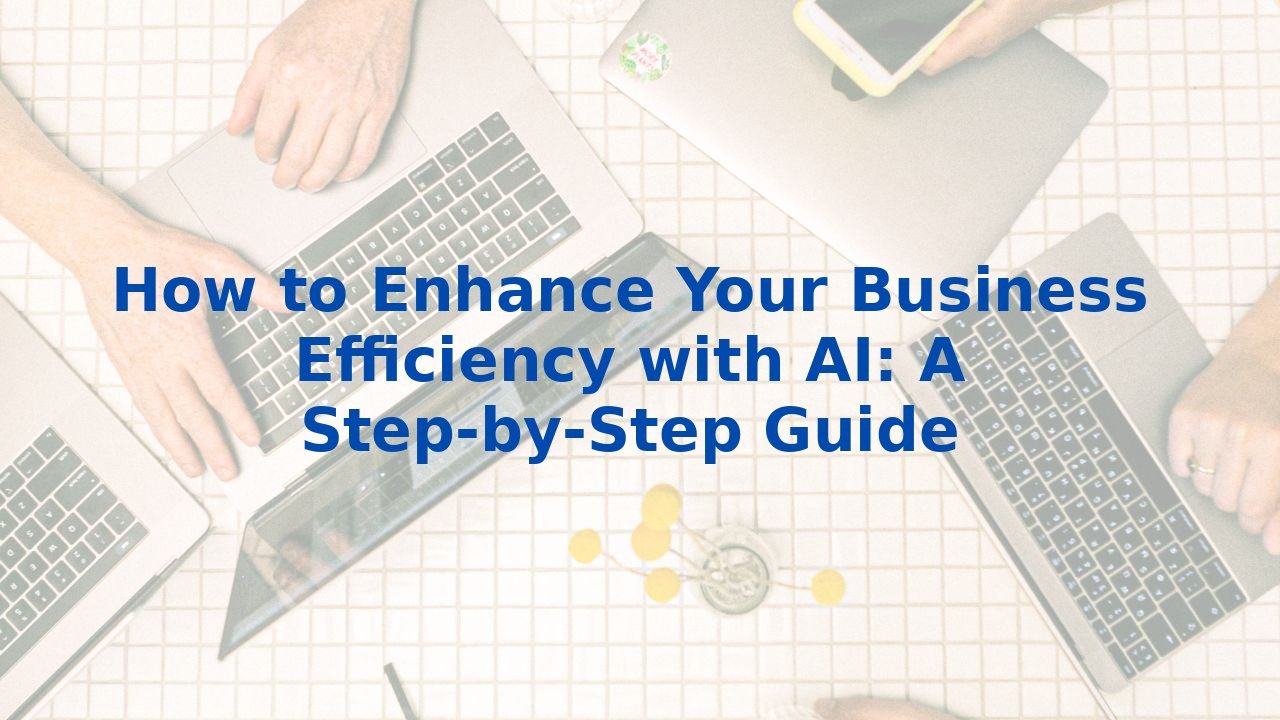How To Enhance Your Business Efficiency with AI: A Step-By-Step Guide
How To Enhance Your Business Efficiency with AI: A Step-By-Step Guide
In a world where speed, efficiency, and adaptability are key to success, organizations must continually innovate and improve their operations. Artificial Intelligence (AI) has emerged as a game-changer, offering remarkable opportunities to enhance business efficiency. In this guide, we will explore actionable strategies that organizations can implement to incorporate AI into their business processes and reap its many benefits.
Step 1: Leverage Data for Enhanced Decision-Making
The backbone of effective decision-making in modern businesses is data. AI takes decision-making to new heights by analyzing vast amounts of information in real time. By employing AI algorithms, organizations can unveil hidden insights and trends that human analysts might overlook.
For example, retailers can utilize AI to scrutinize sales data, keeping track of patterns to ensure optimal stock levels based on predicted demand. This not only minimizes overstock but also ensures customer satisfaction by limiting stockouts. Such smarter decisions lead to reduced operational costs and maximized revenue, all fueled by the power of AI.
Step 2: Automate Mundane Tasks to Boost Productivity
One of the most compelling advantages of AI is its extraordinary ability to automate repetitive and mundane tasks. This automation enables employees to invest their time in more strategic, value-added activities, thereby increasing overall productivity.
Consider the role of AI-powered chatbots that manage routine customer service inquiries. By taking on these tasks, chatbots allow employees to concentrate on intricate issues that require human intuition and creativity. The result? A more engaged and effective workforce working on projects that truly matter.
Step 3: Enhance Customer Experience with Personalization
In an era where customer expectations are at an all-time high, providing a personalized experience can set businesses apart. AI excels at sifting through customer data to deliver tailored recommendations, enhancing customer satisfaction and loyalty.
For instance, online retailers can implement AI technologies that analyze user behavior to suggest products that align with a shopper’s preferences. Such personalized engagement not only skyrockets conversion rates but also fosters lasting relationships with customers, a key to sustainable growth.
Step 4: Achieve Cost Savings Through Resource Optimization
AI can play a pivotal role in optimizing an organization's resources and reducing costs. By lowering the need for manual intervention through automation, businesses can allocate resources more efficiently and significantly cut operational expenses.
Robotics powered by AI, used for order picking and packing, exemplifies this efficiency. Organizations that integrate AI into their supply chain operations can refine inventory levels and lower waste through smart demand forecasting. Companies mindful of these efficiencies see tangible returns, making AI a worthy investment.
Step 5: Propel Innovation and Gain a Competitive Advantage
AI is not merely about tightening operations; it also acts as a catalyst for innovation. As an organization harnesses AI tools, it opens doors to creative solutions and unparalleled insights that promote groundbreaking advancements.
Consider the pharmaceutical industry, where AI analyzes vast repositories of research literature. Such capabilities enable faster, more informed discoveries regarding new treatments and therapies, offering a significant competitive edge. Embracing AI leads to not just refined processes but also a reimagined approach to innovation.
Step 6: Strengthen Risk Management and Fraud Detection
In addition to operational efficiency, AI enhances an organization’s ability to manage risks. AI algorithms can analyze large datasets quickly, identifying fraudulent activities and providing early warnings of potential risks.
For example, financial institutions can use AI to monitor transactions in real time, ensuring that alerts are generated for suspicious activities. The result is not only improved security but also enhanced trust from customers who value a proactive approach to financial integrity.
Step 7: Invest in Training for Effective AI Integration
While the promise of AI is tremendous, the successful integration of AI tools necessitates that employees possess the right skill sets. Investing in comprehensive training is essential, as it empowers teams to leverage AI-generated insights for improved decision-making and workflow integration.
Effective training programs should encompass critical AI-related concepts, focusing on data analysis and practical applications across various business functions. By elevating their knowledge, employees can meaningfully contribute to an AI-driven organization, enhancing both productivity and innovation.
Conclusion
Integrating AI into business processes presents unparalleled opportunities to enhance efficiency, cut costs, and drive innovation. By focusing on data-driven decision-making, automating mundane tasks, and providing personalized customer experiences, organizations can leverage AI to gain significant operational advantages.
Moreover, the commitment to train employees on AI technologies ensures that the workforce is well-prepared and agile enough to meet the demands of an evolving digital landscape. As businesses navigate the complexities of the modern age, integrating AI is not just a strategy—it's a necessity for those seeking sustained growth and competitive dominance.
For organizations eager to embark on this transformative journey, consider exploring training solutions to equip your team with the skills necessary for thriving in an AI-enhanced environment.



